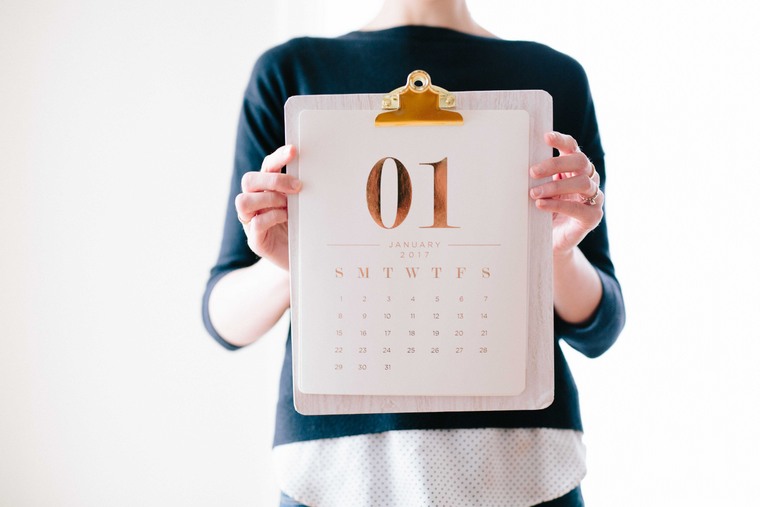The city received a light snowfall on New Year’s eve. The next day, the ground was blanketed in a sheet of whiteness. Our son awoke excited, unaware of the new year, but eager to trod and make his mark on the blank canvas outside. Daniel took him outside, and the kid made a beeline for areas of snow not yet touched, dragging a stick on the ground to make tracks and drawings. “I only like stepping on clean snow,” the kid said.
I stayed indoors with the intent of making tracks of my own in a new moleskine planner, the year 2018 printed on its crisp blank pages. I used my favourite 0.5mm black gel pen, and jotted my first words of the year: the time and date of my first social event of the year (January 2, date night with Daniel to watch Star Wars, 6:45PM). Those first words (and subsequent ones) were by no means profound, but there was such a thrill writing in a planner on the first day of the year.
Anne Shirley of Anne of Green Gables captures the excitement and hope of a new day best: “Isn’t it nice to think that tomorrow is a new day with no mistakes in it yet?”
Mistake of the year
2017 was a good and prosperous year. For the first time since before the first kid was born, Daniel and I were both working full time the entire year. We both received promotions, and associated raises, at work. Our household income was at an all time high.
That made saving easy. We were easily meeting our monthly savings goal and putting more money into paying off the mortgage. At the end of day, we patted ourselves on the back for a job well done. While we saved diligently, we also spent inordinately.
We wanted to update our worn and unsightly though still usable couch; so we got one. We wanted to go camping over the summer, and therefore bought a tent and cooking gear to use. Daniel stumbled across a Le Creuset sale, and I had previously mentioned how a bigger dutch oven would help with my meal prep, so he got me a bigger pot. When I realised my health insurance at work covered portion of laser eye surgery, I pulled the trigger (after years of hemming and hawing); a couple weeks later, I had 20/20 vision.
We also made smaller purchases for items we deemed to add value to our lives. Daniel outfitted our home with smart plugs, switches and Google Home minis. I started a new hobby- watercolour painting- and spent my allowance (and some) on art supplies. When our son committed to reduce his plastic consumption, I went out and purchased Keep Cups and metal straws for everyone.
While we saved diligently, we also spent inordinately.
Our spending wasn’t limited to material objects, but food as well. Having to work long hours in the fall, we relied on the convenience of take-out a lot; we became regulars at the noodle restaurant across the street (which, by the way, make the most delicious hand-pulled noodles). I rewarded myself with treats for a day of hard work. Kicked ass in a meeting? Let’s have a freshly baked chocolate croissant (or two); the kids started thinking “treats” and “afternoon snack” were synonyms (“mama, can we go out for a snack?”).
Inflation lifestyle indeed.
We didn’t spend unreasonably…I don’t think (though some may argue otherwise). Most of our purchases (with the exception of food related ones) were made after careful consideration, research and discussion. We never spent frivolously or impulsively, and we never, ever spent more than we made- not even close.
So what exactly was the mistake?
None, I guess, except, there was always a nagging feeling that something wasn’t quite right.
When is enough, enough?
While I was grateful for to be in a financial situation where I could spend freely without consternation, to be able get what I want, there was always a constant running list of other things I wanted. Okay, now that we have a new couch, I wanted new cushion covers, and a piece of art above the furniture, and maybe even a wall hanging on the other wall to balance room etc. After eating at a delicious omakase meal at a Japanese restaurant, I look up other sushi restaurants to eat at. After taking the big kid to the symphony, I wonder when he’ll be ready for ballet.
To covet, it seems, is human.
So when will I have enough?
I realised, I will never be content with what I have unless I choose to be content.
Wartime Austerity
A decade before the first world war, consumerism increased in America. The nation saw a greater pursuit of material goods, and subsequently, household spending drove prices of goods one-third higher in a single decade. Inflation became a concern for the government, especially during the war. When the US joined in the war in 1917, President Woodrow Wilson urged for frugality: “This is the time for America to correct her unpardonable fault of wastefulness and extravagance.” During the Great World Wars, people practiced frugality to revitalise public virtue and mutual aid; desperate times called for desperate measures. But much can be learned from their way of living, to learn self-restraint and to simply do without.
New Year, New Mentality
With the new year, our resolution here at Urban Departures exercise financial austerity and embark a year of no shopping. The plan is to only spend on necessities for the entire year. The overall focus, the overarching resolution, is to be content with what already have, break preconceived notions of what we need, and acknowledge that what we already have is more than enough.
We had done some small-scale shopping bans in the past- with varying success. One holiday season, we didn’t eat out for 90 days. I gave up shopping for clothes and beauty products one month, only to make purchases on my clothing wishlist at the end of the month because of hard-to-come by sales. None of those experiments made lasting impressions, probably because of duration.
But much can be learned from the wartime austerity way of living, to learn self-restraint and to simply do without.
We had also endured several seasons of frugality. There was that time we were newlyweds, living on a single income with a gazillion dollars in mortgage and school-loan debt. There was that other time we were both unemployed: me on maternity leave, Daniel laid off of work. Adopting austerity measures, we slashed our budgets and lived minimally out of necessity. Similar to the war, no sooner was the period of hardship over when the attitude of self-restraint dissipated; the ideal of simple living losing much of its appeal in time of prosperity. However, we hope that this experiment, not borne of necessity, will help us achieve bigger value-based life goals and preclude a return to lifestyle inflation and the “laissez-faire” attitude towards consumerism.
While we want to save more money and accomplish a number of financial goals set out for 2018 (like paying off our mortgage) we want to consume less, to produce less [waste], to give more generously, and to care more deeply about the world. In exhibiting restraint and denying ourselves of certain wants, we hope to be challenged to be better versions of ourselves.
In the next year, before make a purchase, we will be asking ourselves these three questions:
- Can we use something we already have?
- Can we borrow?
- Can we do without?
As the Dorothy Day liked to say, “The best thing to do with the best things in life is give them up.” Here’s our pledge to do the best thing with the good things in our life.





